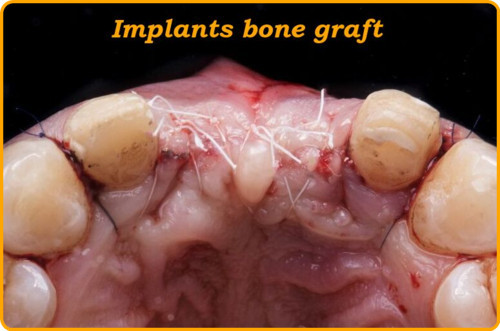
What is a bone graft for implants
What is a bone graft for implants, a very important question because implants are without doubt a great idea if teeth are missing.
However sufficient bone is needed, if not bone grafting treatment is necessary bone grafting or bone augmentation may be necessary for implants.
A bone graft for implants is a surgical procedure in which bone material is taken from one part of a person’s body, or from a donor, and transplanted to another area where bone has been lost or damaged.
The purpose of a bone graft is to promote the growth of new, healthy bone in the recipient area.
A bone graft may be necessary when a person is getting dental implants and there is not enough natural bone in the jaw to support the implant. Without a stable foundation of bone, the implant may fail or become loose over time.
There are different types of bone grafts that may be used for dental implants, including autografts, allografts, and xenografts.
Autografts involve taking bone from another part of the patient’s body, such as the hip or chin.
Allografts use bone from a donor, which may be obtained from a bone bank. Xenografts use bone from an animal, such as a cow.
The bone graft for implants procedure
The bone graft procedure typically involves making a small incision in the gum tissue to access the bone recipient area. The bone graft material is then prepared and placed in the area, and the incision is closed with stitches.
The healing process then begins, with new bone forming around the graft material. This can take several months, after which the dental implant can be placed in the new, stronger bone.
To find out more about what is a bone graft for implants including how much it will cost contact us at Hungarian Dental Implant Centre Wexford.
What are the risks of bone grafting
Bone grafting is a common procedure used to restore or increase bone volume in various parts of the body. It involves taking bone from one area of the body and transplanting it to the site in need.
Although bone grafting is generally considered a safe and effective procedure, there are potential risks and complications that can occur.
One of the most common complications of bone grafting is infection, which can be caused by bacteria entering the wound during surgery or post-operative care. In some cases, an infection can damage the newly transplanted bone and lead to its rejection.
Another potential risk is poor bone growth or integration, meaning the transplanted bone does not properly fuse with the existing bone. This can result in pain, weakness and reduced mobility in the affected area.
Other possible complications include bleeding, nerve injury, chronic pain, and severe swelling.
It is also important to note that each person’s body reacts differently to bone grafting and there may be additional risks depending on an individual’s health history and other underlying conditions.
To minimize the risk of complications, it is important to work closely with a qualified and experienced surgeon, follow all pre- and post-operative instructions carefully, and report any unusual symptoms or concerns to your healthcare team immediately.
The advantages of a bone graft for implants
I am happy to provide you with information about the advantages of bone grafting for implants.
Bone grafting is a surgical procedure used to repair and rebuild bone tissue that has been damaged due to disease or injury.
The procedure involves taking a piece of bone from one area of the body and transplanting it into the affected area to promote healing.
Here are some advantages of bone grafting:
1. Bone regeneration: One of the primary advantages of bone grafting is that it promotes regeneration of new bone tissue.
Grafting can stimulate the body’s natural ability to regenerate bone and can provide a scaffold for the growth of new bone tissue.
2. Increased bone strength: Bone grafting can fortify weakened or damaged bones, which can help in reducing the risk of fractures.
3. Improved joint function: Bone grafting can restore joint function by repairing damaged bones or joints. This is especially beneficial for individuals with conditions such as osteoarthritis or rheumatoid arthritis.
4. Minimal risk of complications: Bone grafting is a safe and effective surgical procedure with minimal risks of complications.
The risk of rejection of bone grafts is low, and allergic reactions are rare.
5. Cosmetically pleasing: Bone grafting can be used to replace missing or damaged bone tissue, restoring the aesthetic appearance of the affected area.
In conclusion, bone grafting is an effective surgical procedure that can stimulate the regeneration of bone tissue and improve joint function, bone strength, and the overall appearance of the affected area.
It is a safe procedure with minimal risk of complications, making it an attractive option for individuals requiring bone repair or reconstruction.

More about dental implant treatment
Dental implants are a popular treatment option for replacing missing, damaged, or decayed teeth.
A dental implant is an artificial replacement for the root of a tooth that is surgically placed into the jawbone. Over time, the bone fuses with the implant to create a strong, permanent base for a replacement tooth or crown, however there are some patients that need answers to what is a bone graft for implants.
The implant itself typically consists of three pieces: the implant, the abutment, and the crown. The implant is the titanium post that is inserted into the jawbone.
The abutment is then attached to the implant and serves as a connecting piece between the implant and the crown. Finally, the crown is placed on top of the abutment and is designed to look and function like a natural tooth.
Dental implants are a highly successful and long-lasting treatment option. They can improve the appearance of your smile, restore chewing and speaking ability, and prevent further damage to adjacent teeth and bone loss in the jaw.
Even though dental implants are favoured by dentists as a long term solution to the issue of missing teeth that may not be suitable for every patient.
Factors such as overall health, gum disease, and bone density can impact the success of the procedure. It is important to consult with a dental professional to determine if dental implants are the right treatment option for you.
In conclusion, dental implants are a popular and effective treatment option for replacing missing or damaged teeth. The process involves surgically placing an artificial root into the jawbone and attaching a replacement tooth or crown.
People often ask how long will dental implants last, to be honest if they are cared for properly including brushing, mouth washing, flossing and regular cleaning at the dentists there is no reason that implants shouldn’t last a lifetime.
Conclusion
In summary, a bone graft for implants is a surgical procedure that involves transplanting bone material to a recipient area where bone loss has occurred, with the goal of promoting new, healthy bone growth.
This can be necessary in cases where there is not enough natural bone in the jaw to support a dental implant.
References
https://pubmed.ncbi.nlm.nih.gov/34369720/


